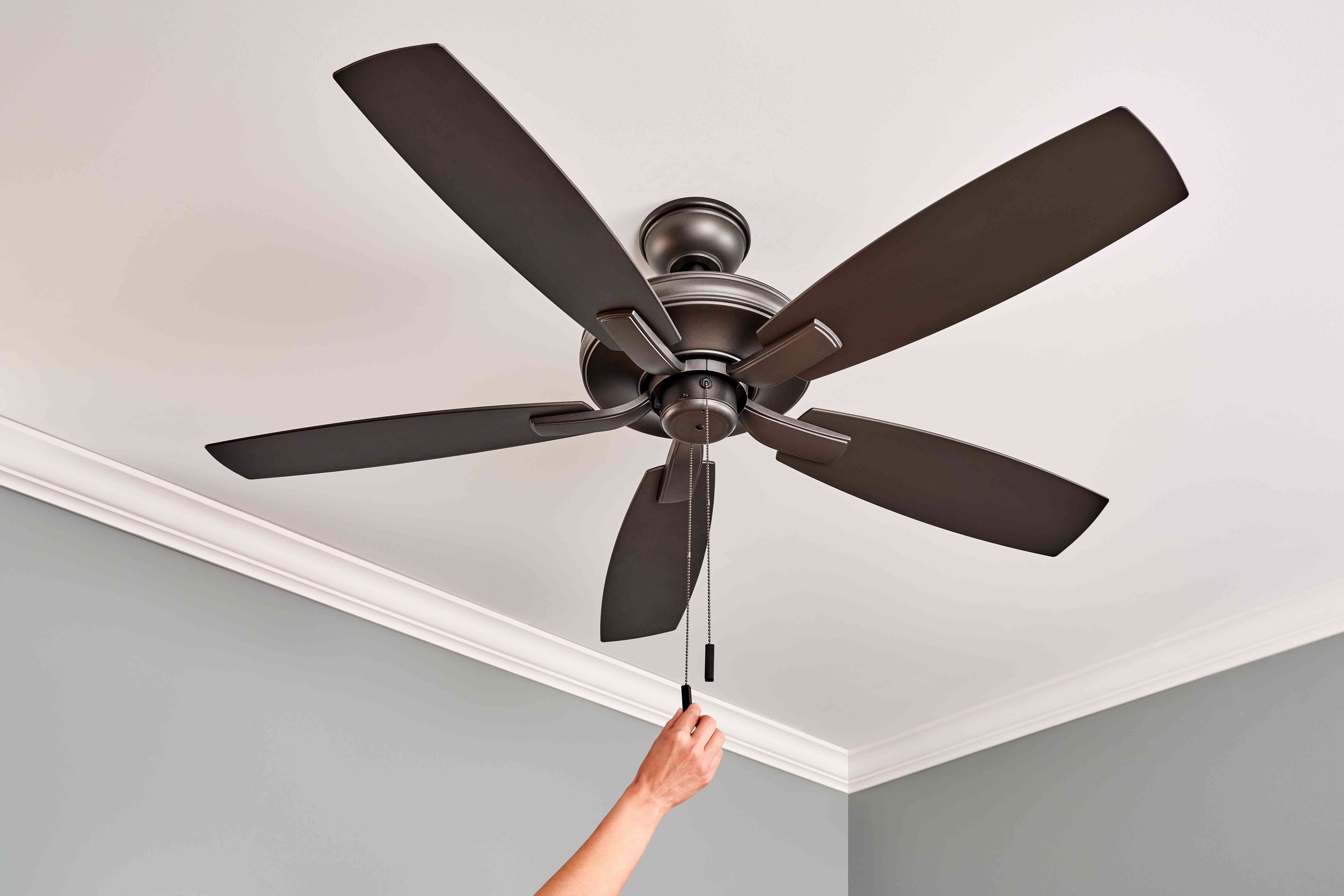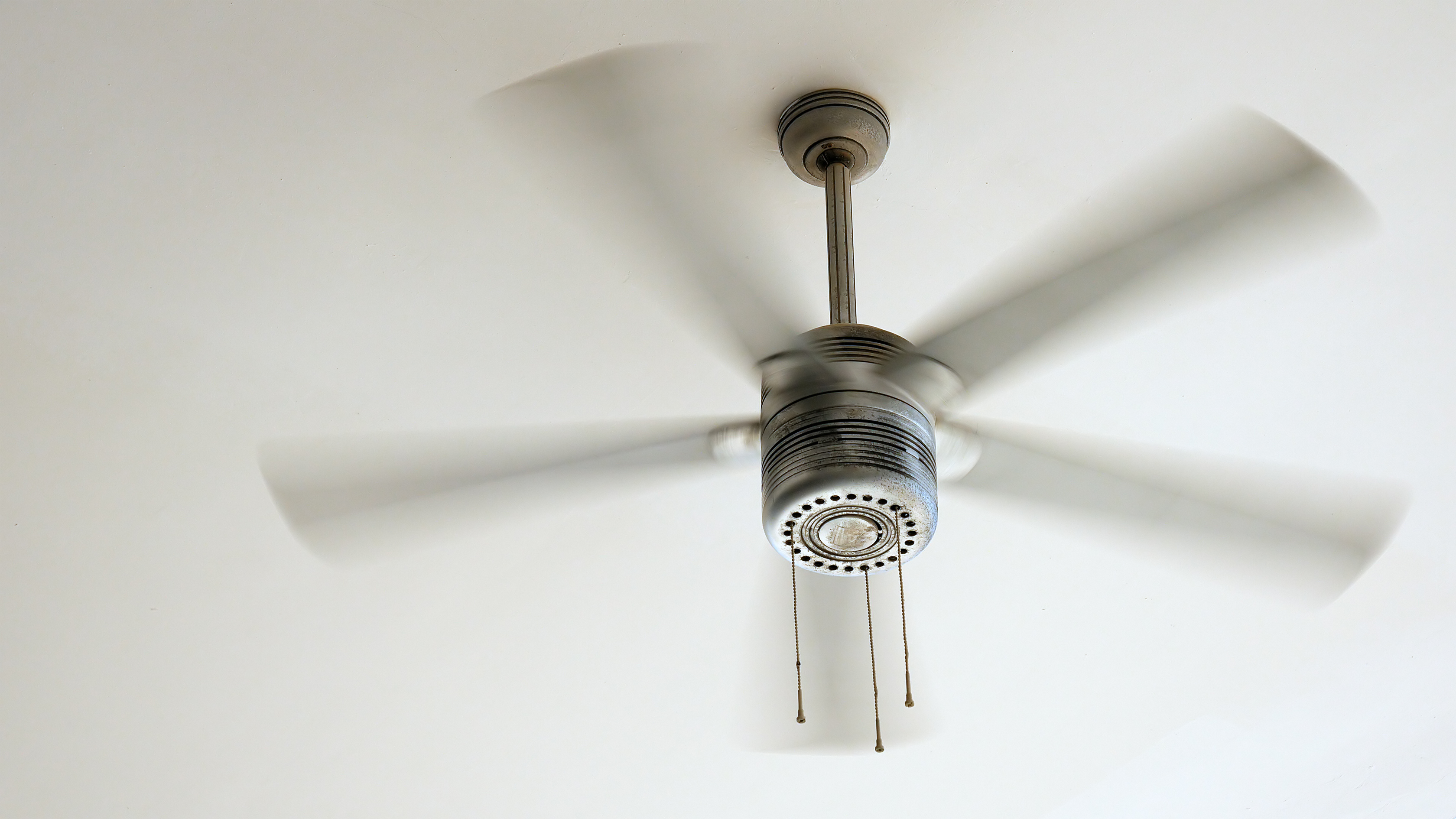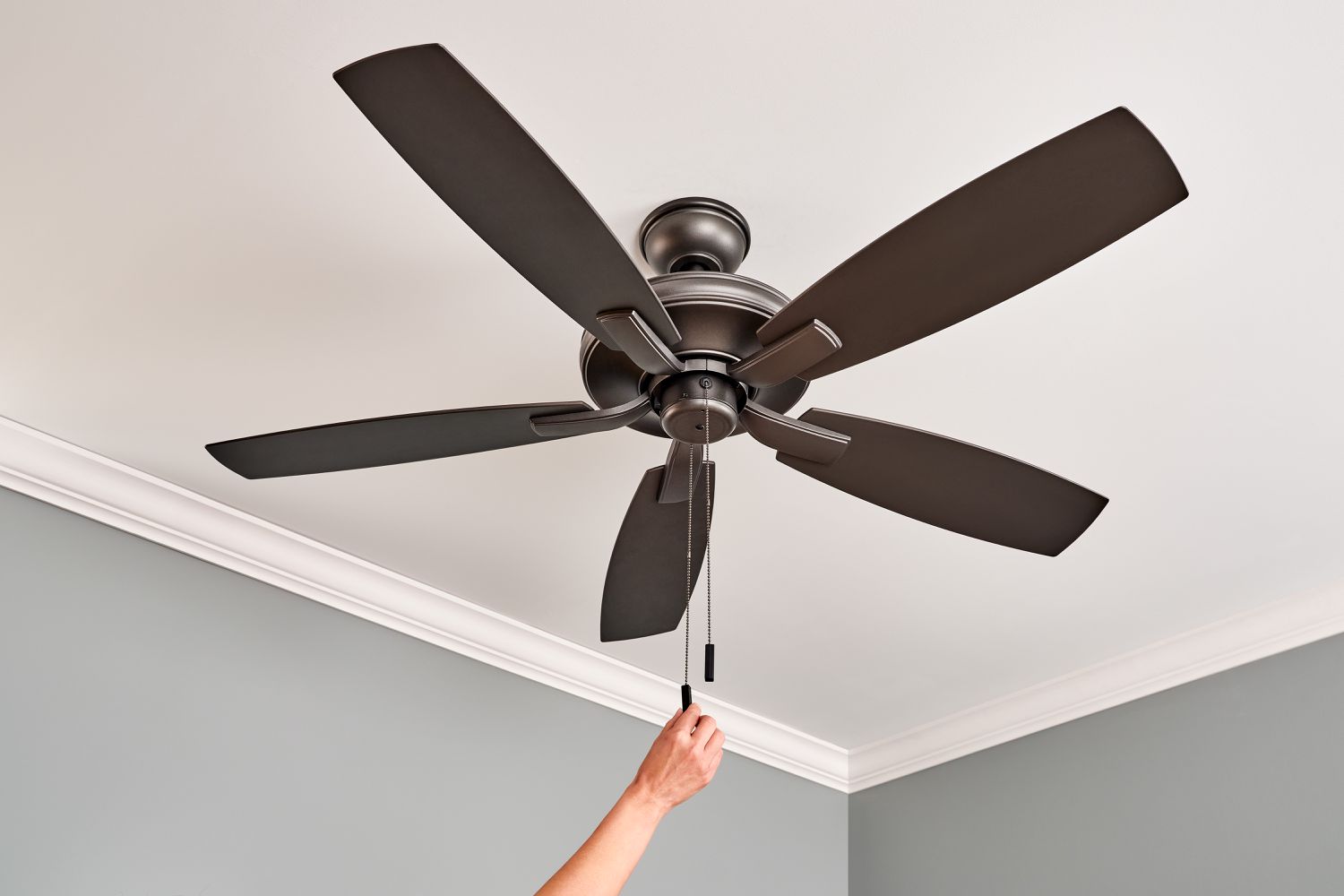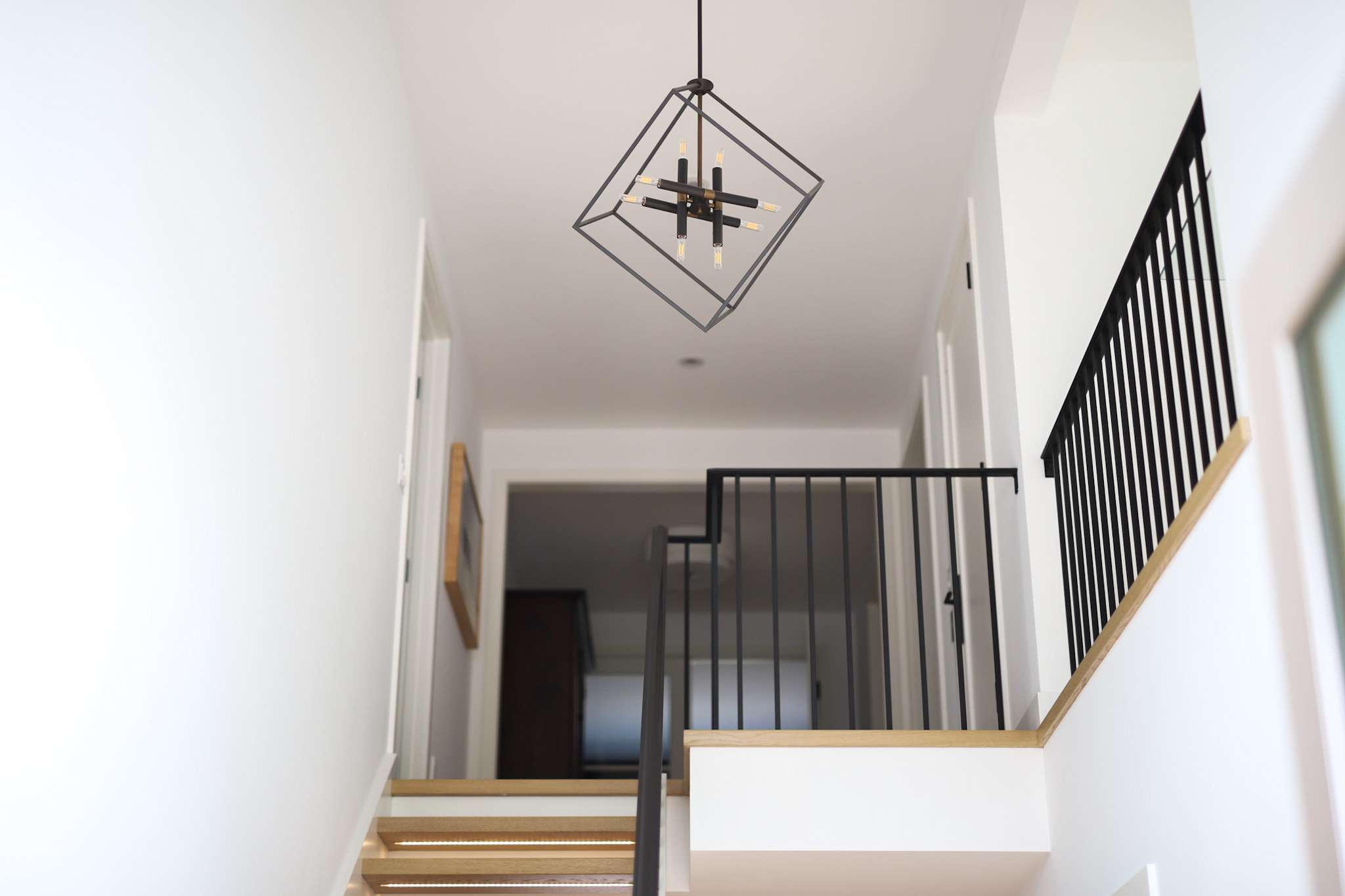

Articles
How Big Should Ceiling Fan Be
Modified: January 19, 2024
Want to know how big your ceiling fan should be? Check out our informative articles for everything you need to know about choosing the right size fan for your space.
(Many of the links in this article redirect to a specific reviewed product. Your purchase of these products through affiliate links helps to generate commission for Storables.com, at no extra cost. Learn more)
Introduction
Choosing the right size of ceiling fan for your space can make a significant difference in terms of both comfort and aesthetic appeal. Ceiling fans are not only functional but also add a touch of style to any room. Whether you’re looking to cool down a small bedroom or keep a large living room breezy, understanding the factors that determine the size of a ceiling fan is crucial.
Factors such as room size, ceiling height, blade span, blade pitch, airflow efficiency, and style all play a role in determining the appropriate size of a ceiling fan. By considering these factors, you can ensure optimal airflow and circulation, as well as a visually pleasing addition to your space.
In this article, we will explore each of these factors in detail and provide guidance on selecting the ideal size ceiling fan for different room sizes and ceiling heights. Additionally, we will touch upon the importance of blade pitch and airflow efficiency in maximizing the effectiveness of your ceiling fan. Lastly, we will consider the importance of balancing style and aesthetic appeal when choosing a ceiling fan for your space.
By the end of this article, you will have a comprehensive understanding of what size ceiling fan to choose for your specific needs, along with the knowledge to make an informed decision that combines practicality and visual appeal. So let’s dive in and discover the key factors to consider when selecting the size of a ceiling fan.
Key Takeaways:
- Choosing the right size ceiling fan involves considering room size, ceiling height, blade span, and airflow efficiency. Matching the fan’s style to the room’s decor enhances both comfort and aesthetic appeal.
- Blade pitch and CFM ratings are crucial for optimal airflow and energy efficiency. Balancing style with functionality ensures the ceiling fan complements the room’s ambiance while providing comfort.
Read more: How Low Should Ceiling Fan Hang
Factors to Consider When Choosing the Size of a Ceiling Fan
When it comes to choosing the right size of a ceiling fan, several factors come into play. Understanding these factors will help you determine the optimal size for your space. Here are the key factors to consider:
1. Room Size: The size of the room is one of the most important considerations when choosing a ceiling fan. A small room will require a smaller fan, while a larger room will need a larger fan to effectively circulate air. To determine the appropriate fan size for your room, measure the square footage and refer to the manufacturer’s recommendations.
2. Ceiling Height: The height of your ceiling is another crucial factor to consider. Ceiling fans need adequate clearance to circulate air properly. For ceilings less than 8 feet high, low profile or flush mount fans are recommended to avoid any safety hazards. For ceilings 8-9 feet high, standard-sized fans work well. For higher ceilings, consider using an extended downrod to ensure the fan is hung at the correct height for optimal airflow.
3. Blade Span: The blade span refers to the diameter of the circle created by the rotating blades. A larger blade span generally provides more airflow. For rooms with square footage between 75-144 square feet, consider a fan with a blade span of 36-42 inches. For larger rooms, a blade span of 44-56 inches is typically recommended.
4. Blade Pitch: The blade pitch refers to the angle at which the blades are tilted. A steeper blade pitch generally generates more airflow. Look for fan models with a blade pitch of 12-14 degrees for optimal performance. However, keep in mind that higher blade pitches may require more powerful motors which can result in increased energy consumption.
5. Airflow Efficiency: The airflow efficiency of a ceiling fan is measured by its CFM (Cubic Feet per Minute) rating. A higher CFM rating indicates better airflow and circulation. Look for fans with higher CFM ratings for larger rooms or spaces that require more cooling.
6. Style and Aesthetic Appeal: While functionality is important, the style and aesthetic appeal of the ceiling fan should also be considered. Choose a fan that matches the décor of your room and complements its overall style. With a wide variety of designs, finishes, and features available, you can find a fan that not only serves a functional purpose but also enhances the visual appeal of your space.
By considering these factors, you can ensure that the size of your ceiling fan is perfectly suited to your room, providing optimal cooling and comfort while enhancing the overall aesthetics. In the next sections, we will delve into the specific guidelines for selecting the size of a ceiling fan based on different room sizes and ceiling heights.
Determining the Right Size Ceiling Fan for Different Room Sizes
To ensure proper air circulation and comfort, it’s important to choose the right size ceiling fan for your room. Let’s explore the recommendations for different room sizes:
1. Small Rooms (up to 75 sq. ft.): For compact spaces such as small bedrooms, bathrooms, or walk-in closets, a ceiling fan with a blade span of 36 inches or less is ideal. These smaller fans are designed to effectively circulate air in confined spaces while providing a gentle breeze.
2. Standard Rooms (76-144 sq. ft.): For rooms of average size, such as bedrooms, offices, or dining areas, a ceiling fan with a blade span of 44-50 inches is recommended. This range offers a good balance between airflow and aesthetics, ensuring adequate circulation without overpowering the space.
3. Large Rooms (144-225 sq. ft.): In larger rooms like living rooms, master bedrooms, or open-plan areas, a ceiling fan with a blade span of 52-56 inches is suitable. These fans provide increased airflow and cover a wider area, ensuring consistent cooling throughout the space.
4. Great Rooms (over 225 sq. ft.): For spacious areas, such as great rooms, open-concept living spaces, or expansive basements, choose a ceiling fan with a blade span of 58 inches or larger. These larger fans can effectively move air across a wide area, ensuring optimal comfort in larger living spaces.
Remember that these recommendations provide a general guideline, and it’s important to consider other factors such as ceiling height, blade pitch, and airflow efficiency when selecting the right size ceiling fan for your room.
In the next section, we will explore the considerations for ceiling height and how it influences the size of the fan needed for efficient airflow and safety.
Ceiling Height Considerations for Ceiling Fan Size
The height of your ceiling plays a significant role in determining the size of the ceiling fan you should choose. Consider the following recommendations based on different ceiling heights:
1. Low Ceilings (less than 8 feet): If your ceiling is less than 8 feet in height, you have a limited clearance for a ceiling fan. In such cases, it is recommended to install a low-profile or flush mount fan. These fans are designed to be mounted directly to the ceiling, minimizing the distance between the blades and the floor. This ensures safe operation and prevents the risk of injury caused by low-hanging blades.
2. Standard Ceilings (8-9 feet): For ceilings measuring between 8 and 9 feet in height, most standard-sized ceiling fans will work well. These fans are designed with a downrod that allows the blades to hang at an optimal distance from the floor. Most fans come with a standard downrod length of 3-6 inches, which is suitable for this ceiling height range.
3. High/Vaulted Ceilings (over 9 feet): If you have a high or vaulted ceiling that exceeds 9 feet in height, you will need a ceiling fan with an extended downrod to ensure proper placement and airflow. Extended downrods come in various lengths and are used to lower the fan to an appropriate level, allowing for optimal air circulation in rooms with higher ceilings.
It’s important to note that when dealing with high ceilings, the total height of the fan, including the downrod, should be taken into account. Measure the distance from the floor to the fan blades to ensure that there is enough clearance for safe operation and easy maintenance.
By considering the height of your ceiling, you can select the appropriate ceiling fan size and ensure proper clearance for safe and efficient airflow. In the next section, we will discuss the importance of blade span and how it impacts the performance of your ceiling fan.
Selecting the Appropriate Blade Span for Ceiling Fans
The blade span of a ceiling fan refers to the diameter of the circle created by the rotating blades. Choosing the right blade span is crucial for ensuring effective air circulation and optimal comfort in your space. Let’s explore the recommendations for different blade spans:
1. Up to 42 inches: Ceiling fans with a blade span of up to 42 inches are ideal for small rooms or areas with limited space. These fans are compact and can provide sufficient airflow for rooms up to 75 square feet in size, such as small bedrooms, bathrooms, or walk-in closets. They are designed to deliver a gentle breeze without overpowering the space.
2. 44-50 inches: Ceiling fans in the range of 44-50 inches in blade span are suitable for standard-sized rooms of 76-144 square feet. These fans strike a balance between airflow and aesthetics, providing optimal cooling and comfort in bedrooms, offices, or dining areas. They offer sufficient air movement without overwhelming the space.
3. 52-56 inches: For larger rooms, such as living rooms, master bedrooms, or open-plan areas, ceiling fans with a blade span of 52-56 inches are recommended. These fans can effectively cover a wider area and provide increased airflow. They are ideal for rooms ranging from 144 to 225 square feet, ensuring consistent cooling throughout the space.
4. 58 inches and above: Ceiling fans with a blade span of 58 inches or larger are suitable for spacious areas, such as great rooms, open-concept living spaces, or expansive basements. These larger fans can effectively move air across a wide area, providing optimal comfort in larger living spaces or rooms exceeding 225 square feet.
Remember to consider other factors such as room size, ceiling height, and airflow efficiency when selecting the appropriate blade span for your ceiling fan. By choosing the right blade span, you can ensure proper air circulation and create a comfortable environment in your space.
In the next section, we will dive into the importance of blade pitch and how it affects the performance of your ceiling fan.
When choosing a ceiling fan size, consider the room’s square footage. For rooms up to 75 square feet, a fan with a 29-36 inch blade span is suitable. For rooms up to 144 square feet, a 36-42 inch blade span is recommended. Rooms over 225 square feet may require a fan with a 50-54 inch blade span.
Read more: How Big Should Patio Be
Blade Pitch and Its Impact on Air Circulation
The blade pitch of a ceiling fan refers to the angle at which the fan blades are tilted. It plays a crucial role in determining the fan’s ability to move air effectively. Understanding the importance of blade pitch and selecting the optimal pitch for your ceiling fan size is essential. Let’s explore further:
Importance of Blade Pitch: Blade pitch directly affects the airflow generated by a ceiling fan. A steeper blade pitch creates more resistance as the blades move through the air, resulting in increased airflow. The angle of the blades determines the fan’s ability to push or pull the air, allowing for better circulation and cooling in the room.
Optimal Blade Pitch for Different Ceiling Fan Sizes: The optimal blade pitch for a ceiling fan depends on its size and intended airflow. Here are some general guidelines:
– For smaller ceiling fans with a blade span of up to 42 inches, a blade pitch of around 10-12 degrees is recommended. This angle provides adequate airflow for smaller spaces without placing too much strain on the motor.
– For medium-sized fans with a blade span of 44-56 inches, a blade pitch of around 12-14 degrees is ideal. This pitch strikes a balance between airflow and energy efficiency, ensuring optimal performance for standard-sized rooms.
– For larger ceiling fans with a blade span of 58 inches or more, a blade pitch of 14-16 degrees is often used. This steeper pitch allows for more airflow and circulation in larger spaces, maximizing the fan’s cooling potential.
It’s important to note that the blade pitch should be considered in conjunction with other factors such as motor power, fan design, and airflow efficiency. Higher blade pitches may require more powerful motors to maintain optimal performance and energy efficiency. Always refer to the manufacturer’s recommendations for the specific fan model you are considering.
By selecting the appropriate blade pitch for your ceiling fan, you can ensure effective air circulation and create a comfortable environment in your space. In the next section, we will explore the concept of airflow efficiency and CFM ratings and how they impact the performance of your ceiling fan.
Understanding Airflow Efficiency and CFM Ratings
When selecting a ceiling fan, it’s important to consider the airflow efficiency and CFM (Cubic Feet per Minute) ratings. These factors play a crucial role in determining the fan’s ability to circulate air effectively and efficiently. Let’s explore these concepts further:
CFM (Cubic Feet per Minute) Rating: The CFM rating of a ceiling fan measures the volume of air it can move per minute. This rating indicates the fan’s airflow capacity and is a key factor in determining its effectiveness in cooling a room. Fans with higher CFM ratings are capable of moving more air, resulting in better airflow and increased comfort.
Energy Efficiency and Airflow: While it is important to choose a fan with a high CFM rating for effective cooling, it is equally crucial to consider the energy efficiency of the fan. Look for ceiling fans that are ENERGY STAR certified, as they have been tested and proven to meet strict efficiency guidelines.
Higher CFM ratings do not necessarily imply higher energy consumption. Modern fans are designed with efficient motors and blade designs that maximize airflow while minimizing energy usage. Look for ceiling fans that are labeled with the Energy Guide label, which provides information on the fan’s airflow efficiency and estimated annual energy costs.
Finding the right balance between a high CFM rating and energy efficiency will ensure that your ceiling fan provides optimal airflow without excessive energy consumption.
When comparing CFM ratings, consider the room size and the specific requirements for that space. A larger room will require a fan with a higher CFM rating to effectively circulate air. It’s important to match the fan’s CFM rating to the room’s square footage to ensure adequate cooling.
Additionally, consider other factors such as blade pitch, blade span, and motor power in conjunction with the CFM rating. These factors work together to determine the overall performance and efficiency of the ceiling fan.
By understanding the importance of CFM ratings and airflow efficiency, you can select a ceiling fan that provides optimal cooling and comfort while being energy efficient. In the next section, we will discuss the importance of balancing style and aesthetic appeal when choosing a ceiling fan for your space.
Balancing Style and Aesthetic Appeal
In addition to functionality, the style and aesthetic appeal of a ceiling fan can greatly enhance the overall ambiance of a room. Balancing the fan’s design with the room’s decor is crucial for creating a cohesive and visually pleasing space. Let’s explore some considerations when it comes to style and aesthetic appeal:
Matching the Ceiling Fan Style with Room Decor: When choosing a ceiling fan, consider the existing decor and style of the room. The fan should complement the overall theme and blend seamlessly with the surroundings. If the room has a modern or contemporary design, opt for a fan with clean lines, sleek finishes, and minimalist features. For a more traditional or classic space, choose a fan with ornate details, wood finishes, and vintage-inspired elements. By matching the fan’s style to the room’s decor, you can create a cohesive and harmonious atmosphere.
Available Options for Ceiling Fan Designs: Ceiling fans come in a wide range of designs and finishes to suit various preferences and room styles. Some popular options include:
– Traditional or Classic Fans: These fans often feature elegant designs, decorative elements, and wooden finishes. They are perfect for creating a timeless and sophisticated look in rooms with traditional or vintage decor.
– Contemporary or Modern Fans: These fans showcase clean lines, sleek finishes, and minimalist designs. They are ideal for contemporary or minimalist spaces, adding a touch of modernity and simplicity to the room.
– Industrial Fans: Industrial-style fans are characterized by their robust construction and utilitarian aesthetics. They are popular in modern, loft-style spaces or rooms with an industrial-inspired theme.
– Rustic or Farmhouse Fans: Rustic fans often incorporate wooden blades, distressed finishes, and rustic accents, bringing a cozy and charming feel to country-style or farmhouse-inspired rooms.
– Outdoor Fans: Designed specifically for outdoor use, these fans are built to withstand the elements while providing both functionality and style. They are available in various designs, from tropical to modern, allowing you to enhance your outdoor living spaces.
Remember to consider factors such as fan size, blade color and material, and the availability of additional features such as integrated lighting or remote control options. These elements can further enhance the style and functionality of your ceiling fan.
By carefully selecting a ceiling fan that matches the room’s decor and style, you can create a visually appealing space that combines both comfort and aesthetic allure.
Conclusion
Choosing the right size of a ceiling fan is crucial for creating a comfortable and visually pleasing space. By considering factors such as room size, ceiling height, blade span, blade pitch, airflow efficiency, and style, you can select a ceiling fan that meets your specific needs and enhances the overall ambiance of your room.
Determining the appropriate size of a ceiling fan starts with understanding the dimensions of the room. From small rooms to great rooms, there are recommendations available based on square footage. Additionally, considering the ceiling height is essential for ensuring proper clearance and efficient airflow.
The blade span of a ceiling fan plays a significant role in determining the fan’s ability to circulate air effectively. Choosing the right blade span based on the room size ensures optimal airflow and cooling.
Blade pitch is another important factor to consider, as it impacts the fan’s ability to move air efficiently. A higher blade pitch generally results in better airflow but may require a more powerful motor.
Assessing the airflow efficiency and CFM ratings of a ceiling fan allows you to determine its level of performance and energy efficiency. Balancing a high CFM rating with energy efficiency helps to strike the optimal balance between cooling capacity and power usage.
Lastly, don’t forget to consider the style and aesthetic appeal of the ceiling fan. Matching the fan’s design with the room decor helps create a cohesive and visually pleasing space. Whether you prefer a modern, traditional, or rustic look, there are various designs and finishes available to suit your taste.
By taking into account all of these factors, you can confidently choose the right size ceiling fan that complements your space, circulates air effectively, and adds an aesthetic touch.
Remember to refer to the manufacturer’s guidelines for specific recommendations and consult with a professional if you have any concerns or questions. With careful consideration and selection, your ceiling fan will not only provide comfort and cooling but also enhance the overall ambiance of your room.
Frequently Asked Questions about How Big Should Ceiling Fan Be
Was this page helpful?
At Storables.com, we guarantee accurate and reliable information. Our content, validated by Expert Board Contributors, is crafted following stringent Editorial Policies. We're committed to providing you with well-researched, expert-backed insights for all your informational needs.















0 thoughts on “How Big Should Ceiling Fan Be”